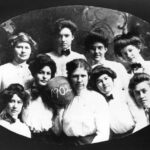Art Meets Technology on the 40 Acres

A scale model of the UT Tower that glows and lights up, a virtual room where everything seems to be right at your fingertips, and 3-D-printed toy soldiers are just a few of the projects created by UT students who are using technology at the new Center for Arts and Entertainment Technology (CAET).
At a recent launch event for CAET, these pieces and many more were exhibited throughout Brazos Hall. Entertainment for the night included a series of performances that combined music and art with high-tech elements, such as a dance performance synced to the beat of a light display.
The CAET opens this fall, and is geared to equip creative students with the technological skills for the 21st-century economy. The third floor of the Fine Arts building, which is known as the Foundry, will be dedicated to audio and visual technology for use by all UT students and staff. This fall, the center will offer a new interdisciplinary degree—the first BS offered in the College of Fine Arts—a Bachelor of Science in Arts and Entertainment Technologies.
Technological advancement in the entertainment industry was a driving factor behind developing the CAET. One of the goals of the Foundry is to improve technological accessibility for students interested in the arts. Doug Dempster, dean of the College of Fine Arts, says there was a demand from students for a space where they can recreate what they see people doing in the music industry and on YouTube.
“There are a lot of commentators who talk about the democratization of technology,” Dempster says. “What they mean by that is … more access for people to create and make art.”

Students are already creating art using technology the university provides. Jared LeClaire, who is working toward an MFA in Integrated Media, designed the Oculus Rift room as his senior thesis. He relished the opportunity to work with other artists and designers.
“I hope this makes us more collaborative. I come from a theater background, and things are very segmented,” LeClaire says. “Somebody does the lighting, somebody does the costuming—something like this, it allowed us to all work in one space, well before we ever even get to the theater.”
Freshman psychology major Christian Woolen has taken several Arts and Entertainment Technology courses, and notes the real-world applications involved.
“What the [CAET] is doing is saying, ‘Hey, this is a thing, pay attention to it,’” he says. “You can major in it, make money. You can major in this and do what you’re interested in.”
Woolen appreciates having the technology at his fingertips to create what he sees in the professional world.
“There is no wrong way, there is no wrong solution. [The CAET] allows you to do you,” Woolen says. “That’s what I love most—having people there to nurture you.”
Top photo by Fabian Villa. Bottom photo by Lawrence Peart.









No comments
Be the first one to leave a comment.